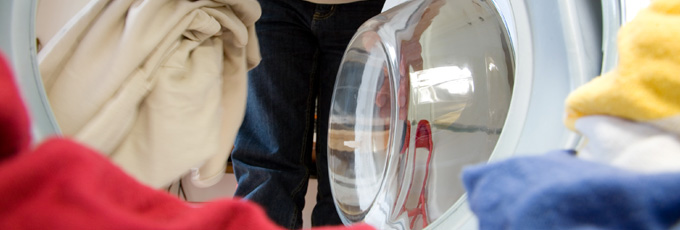How To Easily Clean Your Smelly Washing Machine in 4 Steps
November 10, 2015 | Washing Machines | No comments
I’m going to put this out there; you’re not alone with having a smelly washing machine. In fact unpleasant smells coming from the washing machine is becoming a common problem faced by many – even more so, as more of us begin to wash our laundry at 40⁰C (or lower).
Whilst washing at lower temperatures is a great way for us all to do our bit for the environment and save a few pounds when we do our laundry, lower temperature washes are having a detrimental impact on our appliances, as mould and bacteria isn’t being killed off during the washing process.
To help you remove and prevent unpleasant odours from your washing machine, I suggest you follow the advice outlined below.
Conduct a Maintenance / Service Wash:
Ok, so cleaning your washing machine isn’t the most glamorous task, particularly if you haven’t done it before. But, by taking the time to clean your machine can make all the difference to the performance and efficiency of it.
The best way to clean your washing machine, to remove unpleasant odours, is to carry out a maintenance wash with a dedicated washing machine cleaner.
Such a product cleans and sanitises your washing machine whilst removing the build up of limescale and detergent, which if left will result in those unpleasant odours wafting through your utility room whenever you open your washing machine door.
Carrying out a maintenance wash is as easy as 1, 2, 3…
- Empty your washing machine cleaner, as per the instructions on the packaging, into the soap dispenser drawer.
- Place your washing machine, with the drum empty, onto the hottest wash setting possible.
- Leave your washing machine to run through the complete hot wash cycle, then when it has finished switch the appliance off and leave the door and dispenser drawer wide open to dry naturally.
After carrying out a maintenance wash, the next step to completely remove any unpleasant odours is to manually scrub various components of the appliance – including the door seal, dispenser drawer, dispenser drawer housing and washing machine filter.
Clean Your Dispenser Drawer and Drawer Housing:
If you’ve not taken the soap dispenser drawer out of its housing before, you may be surprised with how much mould can build up within it, and this mould will be contributing to the unpleasant odours coming from your appliance.
To thoroughly clean the dispenser drawer and drawer housing on your appliance, we suggest you watch and follow the instructions outlined in the video below.
Once you’ve cleaned the dispenser drawer and drawer housing, we recommend you leave the drawer open to allow it to dry naturally, as this will help prevent mould and bacteria from building up.
Clean Your Washing Machine Door Seal:
The door seal on your washing machine is often a prime place for mould and bacteria to build up, particularly as few of us leave our washing machine door open following each wash cycle.
Cleaning the seal, however, is relatively straightforward – and to achieve a thorough clean:
- Mix a sachet of the BuySpares Limescale & Detergent Remover with water in a spray bottle.
- Spray the solution over your door seal, making sure to get into any folds and creases.
- Use a clean cloth to wipe clean the door seal, removing any dirt, mould and bacteria which may have built up over time.
- Leave the washing machine door wide open, until the seal has completely dried.
Clean Your Washing Machine Filter:
Although the washing machine filter will not necessarily be directly associated with unpleasant odours building up, it is one part which you should clean on a regular basis if you want to keep your appliance working to its full potential.
Cleaning your washing machine filter should be a relatively quick task, and the easiest way to do so is to follow the advice outlined in this video.
How To Prevent Unpleasant Washing Machine Odours:
Taking the time to clean your washing machine on a monthly basis, as per the advice above, will go a long way to helping keep unpleasant odours from your washing machine. But there are also a range of preventative steps which you can take which will further help your appliance.
- Rinsing off any excess dirt from your laundry before placing it into the machine. If you consider the amount / type of dirt your washing machine handles, it shouldn’t come as any surprise that odours can form.But by taking the time to rinse off as much excess dirt as possible can help to limit the risk of odour build up, and also keep your appliance working effectively.
- Watch your detergent usage. All washing machine detergent comes with recommended guidelines as to how much you should use, depending on the dirt you’re tackling and the water type in your area.By using more detergent than necessary is likely to result in a build up of detergent within your appliance, which leads to those unpleasant odours.
- After every wash cycle leave the washing machine door and dispenser drawer wide open. This allows air to flow through and naturally dry the appliance, reducing the risk of mould and bacteria building up.
- Carry out at least one hot (above 40⁰C) wash a month. Whilst this can be a towel wash (which should be done at 60⁰C), it’s best to carry out a maintenance wash with a washing machine cleaner.
By taking the time each month to carry out a maintenance wash, as described above, and to take the preventative steps mentioned, you can help prolong the life of your appliance, save yourself money in both the short and long term and ensure your washing machine continues to work efficiently and effectively whenever it is called into action.
Help your friends and family make the most out of their washing machine and prolong the life of their appliance, by sharing this post on social media.
Tags: Smelly Washing Machine, washing Machine, Washing Machine Cleaning, Washing Machine Maintenance






